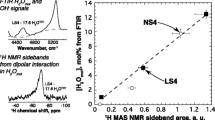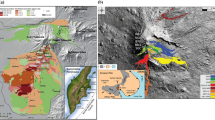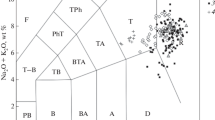Abstract.
29Si nuclear magnetic resonance (NMR), electron spin resonance (ESR) and Mössbauer spectroscopy reveal some influences of magma dynamics on the structure of natural volcanic glasses. Our study concerns three carefully selected pumice samples collected from the Cretaio Tephra, deposited during a small-volume eruption that occurred in Roman times at the Island of Ischia, in the Phlegraean Volcanic District. We analysed glass separated from fragments of these pumice samples, which represent three different stratigraphic members of the Cretaio pyroclastic succession. Erupted during distinct phases of the eruption, these sampled members formed by either magmatic fragmentation or phreatomagmatic processes. Previous geochemical studies showed a homogeneous trachytic composition throughout the Cretaio sequence and a slight variation of the Sr-isotope ratio. The results of microprobe analyses confirm the homogeneous trachytic composition of the glass at the 20 µm scale. The curve-fittings of the 29Si MAS NMR spectra show variable relative proportions of Q4 and Q3 species in the glass structure. The glass/melt extruded during the first phase of the eruption contains a larger amount of Q4 than glass from the later phase, and it has negligible quantities of Q2 species. This finding could indicate that disproportionation reactions such as 2Q<SUP>3</SUP>⇔Q<SUP>2</SUP>+Q<SUP>4</SUP> might not be applied to describe the Q-speciation in highly polymerized natural trachytic melts, and the first erupted glass with the highest amount of Q4 is interpreted as representative of a more polymerized melt, even if chemically indistinguishable from the others. Also Mössbauer spectra show that this glass differs from those extruded during the later phases of the eruption because it contains Fe3+ in network-forming tetrahedral coordination. 29Si cross-polarization–magic angle spinning (CP–MAS) experiments do not reveal a significant contribution of water speciation to silicon depolymerization in glass from surge deposits indicating that the magma probably interacted with water after the melt–glass transition temperature interval was crossed. We suggest that the detected structural variations reflect variable time–temperature paths during rise of different melt batches possibly caused by ascension in a segmented dyke prior to or during the Cretaio eruption.
Similar content being viewed by others
Author information
Authors and Affiliations
Additional information
Electronic Publication
Rights and permissions
About this article
Cite this article
, ., , ., , . et al. Influence of magma dynamics on melt structure: spectroscopic studies on volcanic glasses from the Cretaio Tephra of Ischia (Italy). Contrib Mineral Petrol 140, 532–542 (2001). https://doi.org/10.1007/s004100000209
Received:
Accepted:
Issue Date:
DOI: https://doi.org/10.1007/s004100000209




